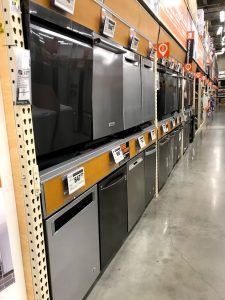In today’s tech-savvy environment, we are blessed to have so many options and features available in our kitchen appliances. But all these state-of-the-art choices can also be confusing and overwhelming to the average homeowner (aka me) when it comes time to buy a new dishwasher.
We need dishwasher, and I’m determined to find the perfect one. How will I do it? By creating a Dishwasher Comparison Worksheet that will help us weed through all the models and find the right dishwasher that fits our family’s lifestyle and is built to last.
And I’ve turned that comparison worksheet in a template to help you navigate through the dishwasher buying process (link below). This worksheet’s goal? To simplify the dishwasher buying experience and ultimately guide you to picking the perfect dishwasher!

Why a Dishwasher Comparison Worksheet?
Why did I create a Dishwasher Comparison Worksheet? Quite simply, we need a new dishwasher and I’ve never bought one before.
I’m an average homeowner looking for not-so-average dishwasher. And at first, I figured it would be easy, right? A dishwasher is straightforward appliance – it cleans, it dries. I expected a handful models with a few different features all within a similar price range. Right?
Nope.

My first trip to the dishwasher section at Home Depot made my head spin. I was inundated with a variety of features and a wide range of prices. Some features I knew we definitely needed, some we didn’t, and some features I wasn’t even sure what they did!
Whew! Too many options and features to consider right then and there in the Home Depot aisle, so I decided to go home and research. I read up on the most common features and added them to a spreadsheet. And this list ultimately turned into the template for the Dishwasher Comparison Worksheet included here in this post.
If you look the template, I didn’t stop there. While the first column lists the common features on today’s dishwashers, I used the second column to decided which features were most important to me and my family’s lifestyle. What were my must-have features? Which features were unnecessary? And which features, in all honesty, I just wasn’t sure if I needed?
From there, we then researched individual dishwasher models online as well in-person at the usual big box store culprit. We found dishwashers within our budget and entered their features into the Dishwasher Comparison Worksheet.
How Can This Dishwasher Comparison Worksheet Help You?
This worksheet can help simplify the dishwasher buying process and ensure that buy a dishwasher that fits your budget and lifestyle. How? This worksheet is a comparison template that you complete with models of your choice in order to compare and contrast models and pick the right dishwasher.
Click HERE to get the Dishwasher Comparison Worksheet!
Use this worksheet (the same way I did), with these 3 easy steps:
- Identify the essential dishwasher features that fit your lifestyle
- Shop for those models that fit your desired features (and within your budget). Enter the features into the Comparison Worksheet template.
- Compare and contrast these models to choose the perfect dishwasher!
Using this spreadsheet avoids confusion and feeling overwhelmed during the buying process. It keeps track of all the important features of each model so you can compare models side by side and ultimately buy the perfect dishwasher.
IMPORTANT: You MUST save a copy to your own Google Drive or to Excel. Otherwise, you will change the template and we will all see your work!
How exactly do you do that? Simple
File -> Make a a Copy or File -> Download
(Note that you have an option to download as a Microsoft Excel spreadsheet.)
If it doesn’t work, please let me know!
Once downloaded please continue reading below to learn more about new dishwashers and how to complete this Dishwasher Comparison Worksheet. At the end of this post I talk about bout buying process and how we eventually bought our new dishwasher (we haven’t pulled the trigger yet).
Common Dishwasher Features
Below is a list of fourteen features that you need to consider when buying a dishwasher. Feel free to jump around by using the links directly below.
And FYI, each of these features directly correspond with the information in the Dishwasher Comparison Worksheet. (I do what I can to make things easy for you ?)
- Type
- Finish/Exterior Style
- Control Panel Location
- Handle
- Interior Tub Material
- Filtration or Hard Food Dispenser
- Cycle Features
- Interior Capacity
- Noise
- Energy Efficiency
- Smart Tech
- Warranty/ Reliability
- Rating
- Budget
If you would rather listen and learn about common dishwasher features (versus reading this post) I’d recommend this episode of the Fix-It Home Improvement podcast. If you follow this blog, then you know that I love this podcast and list it as one of the top 4 Podcasts for Every Old House Enthusiast.
1. Type
There are three main types of dishwashers – built-in, portable, or countertop. Your choice on which type to buy will depend on greatly on whether you are renting or own your home, how much space you have, and the size of your household.
Built-In: Conventional built-in dishwashers are the most widely sold type. These dishwashers have unfinished sides and are installed under your countertop. The 24-inch models are the most common, but are also available in 18-inch compact units for smaller homes and apartments. This post focuses on this type of dishwasher.
Portable: For renters or homeowners with kitchens that simply don’t have the space for a built-in dishwasher, portable dishwashers are a great choice. These dishwashers on wheels can be stored out of the way, then easily rolled into your kitchen and hooked up to your kitchen faucet.
Countertop: Countertop dishwashers are another option for renters or homeowners who don’t have enough space to install a built-in dishwasher. These dishwashers are small enough to sit on your countertop and connect to your kitchen faucet.
2. Finish/Exterior Style

The finish of your dishwasher should match the style of the other kitchen appliances. Dishwashers come in a variety of finishes, including white, bisque (aka off-white), black, slate, stainless, and black stainless.
Some dishwashers even offer the ability to hide behind a cabinet panel as that it matches your kitchen cabinetry, which results in a seamless look. Note that some finishes can be more expensive than others.
3. Control Panel Location
Currently there are two common configurations for the control panel – Front or Top.There is no difference in functionality – similar to the finish, it’s about style and aesthetics.
Front- Facing Control Panel
Front control dishwashers have the controls on the outside front of the door and remain visible with the door closed. This is the classic dishwasher look – what I usually see in my family and friend’s homes.
Pros:
- Easy to see controls. You will know that the machine is running and can easily monitor its progress.
- Usually available on budget or a mid-end models
Cons:
- Increased risk of accidentally pressing buttons if you lean against the appliance
- Young children like to push the buttons (I speak from experience – these buttons can be irresistible to toddlers!)
Top or “Integrated” Control Panel
For a more simplified look, some dishwashers have the controls in the top of the door so that they’re hidden when the door is closed.
Pros:
- Sleek, seamless and minimalist look
- Avoid accidental button pushes
- Easier to matching hardware of other appliances
Cons:
- Can’t see cycle progress
- Commonly smaller buttons or a smaller control panel overall
- Usually more expensive models
Some higher-end dishwashers have partially hidden controls. What does that mean? You’ll at least know that the dishwasher is on and possibly the remaining cycle time.
4. Handle
Like the control placement, the handle configuration is one of the biggest contributing factors to the aesthetics of a dishwasher but provide no difference in functionality.
Dishwasher handles vary depending on the style. Standard choices are pocket, recessed, and bar handles. For a more modern kitchen, recessed and pocket handles tend to be more popular. Pocket handles tend to match most other style of appliances, so they can be a popular choice when replacing just the dishwasher. Both recessed and pocket handles are usually easier to clean, but bar handles are a bit easier to grip and open.
5. Interior Tub Material
The interiors tubs of dishwashers come in either plastic or stainless steel (some newer models offer a hybrid). Basic models will have plastic tubs while the upgraded ones usually contain stainless steel.
Most experts say that stainless steel will not improve washing performance, but stainless steel cavities still have some advantages:
- Better sound dampening
- Reflect heat better for more energy-efficient drying
- More capable of withstanding the high temperatures of sanitizing rinses.
- Stainless steel washing arm is more durable.
6. Filtration or Hard Food Disposer

Older and current basic models use a basic filter system to trap the food washed off your dishes during a wash cycle. Food is collected in a filter at the bottom of the dishwasher. Some filters are self-cleaning, while other filters must be removed and cleaned manually.
A newer option is the hard food disposal, which includes a chopper installed right into the dishwasher. The chopper disintegrates food particles so they don’t end up just swishing around the dishwasher during cleaning. This means you can skip scraping and rinsing your dishes before loading them into the dishwasher. The cons of this feature is that it louder than the filter option, and sometimes adds time to the wash cycle.
7. Cycle Features
Dishwashers, even the budget ones, typically have more cycles than just a normal wash and dry (i.e. quick wash and heavy wash for pots and pans). Beyond that, there are a variety of settings. I can’t give an exhaustive list, so here’s some common ones.
- Delay wash cycle allows you to load the dishwasher and set a start time later in the day to run.
- Rinse/ Hold cycle works for partial loads. It rinses food off dishes (before it dries and gets stubborn) and removes bad smells without using detergent.
- Delicate wash cycle allows for a lighter wash cognizant of glassware and other fragile dishes.
- Sanitize cycle raises water temperature above the typical 140° F to around 155° F. This slightly increased temperature will disinfect and kill 99.9% of bacteria on dishes.
- Soil Sensor wash relies on a sensor to monitors how dirty (or clean) the dishes are and adjusts the temperature and length of cycle accordingly. This setting helps with energy-efficiency.
Which cycles do you need? I can’t answer that. You have to think about how you want to use your dishwasher. Just remember – the more cycle settings, usually the more expensive dishwasher.
8. Interior Capacity

While most built-in dishwashers have a standard exterior size (24 inches high x 24 inches wide x 35 inches deep), each have different capacities. What does that mean? Manufacturers measure capacity by the number of place settings that comfortably fit inside. Capacity can range from 12 to 16 place settings.
Honestly, as an average homeowner, that’s not an overly helpful measurement. When I load my dishwasher, it has a variety and size of dishes. I never place just main place settings in the dishwasher. I have a hodgepodge of dishes, pots, tupperware, water bottles, etc . Place settings isn’t a tangible measure of what I can fit inside my dishwasher easily and effectively.
Instead, you should focus on finding a dishwasher with enough flexibility to fit your needs. Where do you find that flexibility inside a dishwasher? Through the different features associated with a dishwasher’s racks and tines.
Racks
- Adjustable racks: Many dishwashers have adjustable or removable racks, which can allow you to reconfigure the interior. This helps fit bigger plates in the bottom or taller glasses up top.
- Third rack: This shallow drawer at the top of the dishwasher interior suits well for oversized utensils and small items. The only con is that it limits the height of the second rack which can be an issue if you have a lot of tall glasses (we do).
Tines
- Adjustable or fold-down tines: This feature allows you to pack your dishes in more efficiently from load to load.
- Spacing: A dishwasher with less space between tines accommodates more dishes, with wider spaces between tines accommodating a smaller number, but larger-sized dishes.
Think through what interior configuration works best for how you cook and eat. Do you load a lot of big dishes or small dishes? Maybe you have thick stoneware dishes that need wider space between tines. Or maybe tall glasses that need more headspace on the top rack?
When shopping for your next dishwasher, open up each model and really look at it. Will it fit your needs? Don’t be shy and bring one or two of your more commonly used dishes to the store. I bring a dinner plate and one of my kid’s tall water bottles. In my old dishwasher, if I placed my dinner plates just a certain way the washing arm was blocked (and didn’t wash the load effectively), so my new dishwasher needs a higher clearance between the bottom and top racks.
Silverware Baskets
Most dishwashers come with a silverware basket that can be taken out of the dishwasher for unloading ease. The location of the cutlery basket is just a matter of preference. It doesn’t affect washing performance.
There are two common locations for the silverware basket. Either it sits on the bottom rack, or is attached to the inside of the dishwasher door. When attached to the door, it tends to take up less room, but is usually a smaller basket.
As for the baskets itself, individual silverware slots keep utensils from sticking together and help them get more thoroughly clean.
9. Noise (dBa)
All dishwashers are rated on noise level through a dBA rating or the decibel level. The lower the decibel, the quieter the dishwasher.
Most new dishwashers are relatively quiet. But if you bothered by small noises, or have your bedroom near the kitchen, or entertain a lot in your kitchen you might want to be cognizant of your dishwasher’s decibel level.
You should expect a standard dishwasher to operate between 45-60dBA. The quietest dishwashers are around 40dBA and under.
Note that the decibel rating is an average of the sound level for an entire cycle, including the dry cycle (aka the silent cycle), which can be misleading.
10. Energy Efficiency
Today’s dishwashers use less energy and water than older models. That equates to lower utility bills and conserving energy and the environment (YIPPEE!) The easiest way to determine if a dishwasher is energy efficient is to look for the ENERGY STAR label.
ENERGY STAR dishwashers exceed federal standards for energy use by at least 25 percent.
But there are other dishwasher features to save water and electricity (some already discussed above under Cycle Features):
- Delay-start feature allow you to program your dishwasher to run during non-peak hours. This is especially helpful. if your electricity rate is calculated on time-of-use.
- Soil Sensor setting that can adjust cycles and water use according to the load’s soil level. The dishwasher will use no more energy or water than actually necessary.
- Eco-wash, low water, and rapid wash cycles as well as half-load settings for those times when you don’t have a full dishwasher.
- No-Heat Drying option that doesn’t use any heat
11. Smart Tech
With technology advancing everyday, high-end dishwashers can come with enhanced features to make life even earlier. Dishwashers with “smart” technology can connect to a smartphone app or virtual home assistant.
Through these sophisticated smartphone apps, you can check on wash cycle progress, get notified when a load is complete, or stop working if a leak is detected. For example, through LG’s SmartThinQ app, so you can check on the dishes, get alerts when a cycle is complete or see the remaining time from anywhere. It even works via voice commands using Google Assistant and Amazon Alexa.
12. Warranty/ Reliability
Warranty terms and conditions differ by manufacturer, so it’s good to know for how long you are covered if you happen to buy a dishwasher that has issues. Warranty can be correlated with number of service calls. Below are statistics for percent of service calls performed by a large appliance distributor (Yale Appliance) by manufacturer in my geographic area (outside of Boston, MA). These stats below are based on 34,687 service calls performed in 2018 by Yale Appliance.
At a Glance: Reliability for Major Brands (Yale Appliance)
- Whirlpool 6940 Sold | 312 Serviced – 4.5%
- LG 3,085 Sold | 168 Serviced – 5.45%
- Samsung 6,352 Sold | 541 Serviced – 8.52%
- Gaggenau 251 Sold| 27 Serviced – 10.76%
- Bosch 6,751 Sold | 754 Serviced – 11.17%
- Maytag 3,363 Sold | 407 Serviced – 12.10%
- Miele 2,235 Sold | 298 Serviced – 13.33%
- Wolf 2173 Sold | 399 Serviced – 18.36%
- Fisher Paykel 568 Sold | 112 Serviced – 19.72%
Consumer Reports (CR) just came out with a customer survey on the Most and Least Reliable Dishwasher Brand. And I was surprised to hear from CR’s experts that “around a quarter of all newly purchased dishwashers are likely to break within the first five years”. Therefore it is important to understand what your warranty will (or won’t) cover on your new dishwasher.
13. Ratings
I firmly believe in ratings as an indicator of how well an appliance will perform. Every manufacturer touts advances technologies that differentiates them from the competition, such as:
- Bosch with CrystalDry
- KitchenAid with ProScrub
- LG with QuadWash and TrueSteam
- Maytag with PowerBlast
- Whirlpool with TotalCoverage spray arm
But as the average homeowner, I honestly, have no idea if these fancy state-of-the-art technologies truly get the job done. Not until I read homeowners’ ratings and reviews and see which models work (and which models don’t).
So be sure to check the ratings of the models you are considering online. There are lots of places to check – the manufacturer’s website, Lowes, Home Depot and Amazon. And if you are a member of Consumer Reports, check out their recent review on almost 150 different dishwasher models.
14. Budget
Let’s face it. The majority of homeowners are working with a budget when it comes to replacing appliances. The average cost of a new dishwasher? While a bit dated (2016) Angie’s List estimates the average cost runs about $400 to $700.
While that range is fairly (small (about $300) dishwashers do have a wide range of prices. Homeowners on a tight budget can buy a decent basic dishwasher for as low as $250. Those with deep pockets looking for all the amenities can spend more than $2,000.
Which Dishwasher Did We Buy?
As of the date of publishing (October 2019), we actually have not bought our dishwasher. Yet. We have narrowed down our choices to a few models, but we haven’t actually pulled the trigger. Why? We are deciding on the best time to buy. Some folks say September and October is the best months, while others suggest we should wait until Black Friday.

As you’ll see from the second column of the Dishwasher Comparison Worksheet, I entered which features we wanted, didn’t want, and were not sure of (or didn’t have a preference). An example of a “not sure” is the interior tub material. While I admit that the looks of a stainless steel interior would be sleek and beautiful, it’s not a must-have for me. While experts note its benefits, they also note that plastic tubs should last longer than most people keep a dishwasher.
But which features were we sure of? We definitely wanted a built-in with a stainless steel exterior finish to match our other appliances. And we were sure of a few features and interior configurations that were important to us, such as:
Control Panel Location
Our current dishwasher has a front panel. Honestly I didn’t even know that a top control panel even existed. It’s a pretty sleek feature, I’ll admit. But after much thought, we decided to stay with the traditional front control model.
Why you ask? Especially since we have little kids that love, love, LOVE to press buttons? Well, I know my habits in the kitchen. Quite honestly, I’m a bit scatterbrained. I need to know if my dishwasher is on and where it is in its cycle. And yes, my kids hit the buttons right now, but in about a year, those buttons won’t look as enticing and they will stop.
Delay start
This feature is on my old dishwasher and use it every day. I load the dishwasher after dinner, but don’t run it since we still have cups lingering until bedtime (and sometimes dessert plates). At the end of the night, whoever is left standing (usually my husband ) can just toss those few items into the dishwasher before going up to bed. I love the set-and-forget experience of the delay start. In the morning, I come downstairs to a kitchen with a clean dishwasher.
Sanitary cycle
I also love this setting, especially in the winter during cold season with 3 young kids who love to share their germs. Honestly, I don’t know if it really works or not (maybe the 140° F is good enough?) but I still want this setting.
Third rack
This is a feature that we definitely don’t want. We struggle with our tall dinner dishes fitting in the bottom rack of our current dishwasher. Adding a third rack to our new dishwasher would take up height that we desperately need down in the bottom rack.
Silverware basket
With a family of 5, we use a lot of silverware. Dishwashers have silverware baskets in one of two locations: either in the dishwasher door or in the bottom rack. The baskets that fit in the dishwasher door tend to be smaller, so our lifestyle lends itself to the larger silverware basket that fits in the lower rack.
I’ll keep you posted on our buying process! Have you recently bought a new dishwasher? What do you recommend?
And if you download and use the Dishwasher Comparison Worksheet I’d love feedback!
This is such a great resource! Thanks so much for putting it together. Definitely saving this for our kitchen reno coming up.
Thanks for sharing this! I wish we had thought about the control location! Our little one loves to push the buttons on the front and “help” lol
Cheers, Denise and Sean
Ah, yesI completely sympathize. My 3-year old twins are definite “helpers” with the dishwasher 🤣